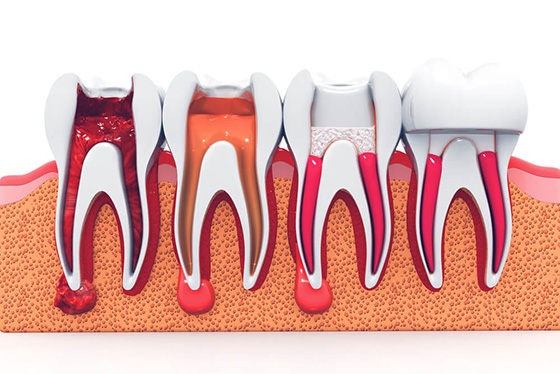Quality Root Canal Therapy In Reno, NV
“Root canal” has become a scary term for dental patients to hear, but the benefits of the procedure and advances in dental technology have made it much less “scary”. Local anesthetics and proper pain medication allow the procedure to be performed with little to no pain in most cases. There may be some soreness following the procedure, but that is normal for most dental procedures. Over the counter painkillers are usually enough to relieve any pain afterwards, but your dentist may prescribe medication. The procedure will also relieve you from pain caused by the infection allowing you to enjoy all the foods you love without any pain from heat, cold, or biting too har
What Is A Root Canal?
Endodontics, more commonly known as root canal therapy or a root canal procedure, can relieve the pain caused by diseased or injured pulp tissue in the center of the tooth.
Historically, a tooth with a diseased nerve would be removed immediately, but endodontists are now able to save the natural tooth in most cases with root canals. Root canals involve extracting the inner tooth structures, then sealing the resulting gap with a crown, restoring health and functionality to damaged teeth.
After a well-performed root canal treatment, you should have no lasting pain or sensitivity in the tooth and with good oral hygiene, and the tooth should last for years. With most patients, we use local anesthetics that will make your treatment as comfortable and pain free as possible.
Do You Need a Root Canal?
Endodontic treatment is necessary when the soft tissue inside the root canal becomes inflamed or infected. If this inflammation or infection is left untreated, it can cause pain and eventually lead to an abscess.
Signs and symptoms of endodontic problems include:
- Inflammation and tenderness in the gums
- Teeth that are sensitive to hot and cold foods
- Tenderness when chewing and biting
- Tooth discoloration
- Unexplained pain in the nearby lymph nodes
What Does Root Canal Treatment Involve?
On the day of the procedure a local anesthetic will be typically be administered, unless you and your dentist have discussed other options.
The first step in a root canal procedure is to gain access to the inner tooth. If a temporary crown and post have been placed, these will be removed.
Next, filling material and obstructions that block the root canals will be removed. Small instruments will then be used to clean and reshape the root canals. X-rays may be taken to ensure that the roots are thoroughly clean.
When the root canals are completely clean, gutta-percha is used to pack the space. This rubbery material seals the canals to prevent bacterial invasion. Finally, a temporary crown or filling is applied to tooth. At a later date, the color-matched permanent crown will replace the temporary crown.
Schedule An Appointment
If you are experiencing discomfort or tooth pain, please make an appointment as soon as possible.

